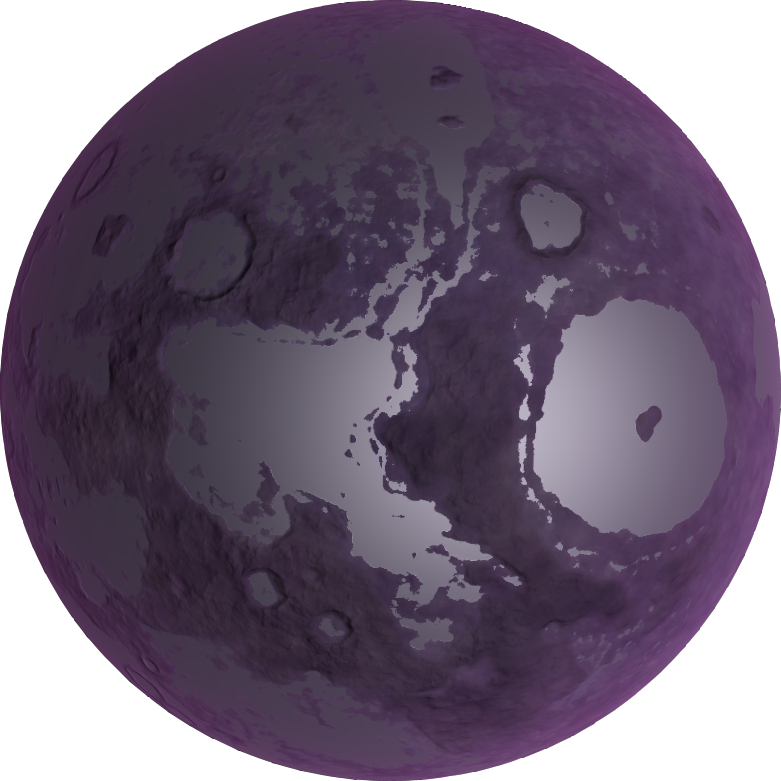Eve
Eve is the second planet from Kerbol, the closest planet to Kerbin, and KSP's analogue for the planet Venus. It has one small moon: a captured asteroid called Gilly. Because of the atmosphere it's the hardest planet to return from after landing. There is a tutorial about getting to Eve.
In-game Description
Eve is certainly the purplest object in the solar system. Its one of the larger, most visible objects, mainly because of its very, very purple tint. It is considered by some to be an almost sister planet to Kerbin. Well, despite the purple, and the toxic atmosphere, and the extreme pressures and temperatures… Actually, it’s not very similar at all is it? Who are these people?
Topography
The surface of Eve looks not unlike that of Saturn's largest moon, Titan. It has several oceans, among which lie large, flat continents. The terrain has a few mountain peaks, but mostly consists of rolling hills that resemble purple sand dunes. These are speckled with small boulders, no doubt worn down by Eve's pressure, temperature, and wind. Eve's surface is covered with craters. The composition of the violet liquid which fills the oceans and lakes is unknown, although water remains a possibility: the boiling point of water is slightly higher than the surface temperature when taking the high atmospheric pressure into account. According to the devs during a livestream, it was joked that the lakes were made of rocket fuel. Eve's highest mountain range has a peak of 7526 m.
Atmosphere
Eve's atmosphere begins at 96,708.6 m and is extremely dense: at 11,250 m, it's as thick as Kerbin's atmosphere at sea level (1 atm), and at Eve sea level the atmospheric pressure is 5 atm. Its atmospheric pressure fades exponentially, with a scale height of 7000 m. The atmosphere should be superheated due to the thick atmosphere trapping in heat, much like Venus, but this is not currently implemented. From within Eve's atmosphere, the sky appears indigo during nighttime and a violet-purple color during daytime. During dawn and dusk, the sky is green. Jet engines do not function in Eve's atmosphere, since it contains no oxygen — they make noise and consume fuel, but they produce no thrust. Planes with other propulsion methods do, however, work very well, and are a great way to explore the planet. They work best between 35 km and 25 km where the atmosphere generates enough lift to glide and steer, but not enough drag to slow the aircraft excessively. Landing legs on Eve can easily break because of Eve's high gravity and, surprisingly enough, atmospheric pressure. As with version 0.24.2[outdated], an aerobraking maneuver arriving from Kerbin and resulting in orbit around Eve — without using fuel for braking — can be done aiming for a periapsis between 70 km (for low-energy transfer) and 55 km (for high-energy transfers). The following table gives terminal velocities at different Eve altitudes. These are also the velocities at which a ship should travel for a fuel-optimal ascent from Eve, given the game's model of atmospheric drag.
| Altitude (m) | Velocity (m/s) |
|---|---|
| 0 | 58.4 |
| 1000 | 62.6 |
| 5000 | 82.9 |
| 10000 | 118 |
| 15000 | 167 |
| 20000 | 237 |
| 30000 | 477 |
| 40000 | 962 |
| 50000 | 1.94x103 |
| 60000 | 3.91x103 |
Science
Eve's orbit and atmosphere have a science multiplier of 7, which is rather average. But the surface has a multiplier of 12, which is the highest science multiplier in the whole star system. Eve has no biomes, only the default "global" context for science activities. Some players have mistaken the difference in results given when in water and the header "from Eve's oceans" for a second biome, but this is default terminology coded for a "SrfSplashed" splashdown situation also seen on Laythe.
Natural satellites
Eve's only natural satellite is the tiny captured asteroid Gilly in a highly eccentric and inclined orbit. Gilly is the smallest celestial body in the Kerbol system.
Orbital Statistics
Visiting Eve potentially requires the least delta-v of any planet because its huge gravity well and dense atmosphere mitigate the difficulties that its slight relative inclination poses and greatly ease aero-captures, transfers, and landings; unfortunately, takeoff and escape therefore require the most delta-v of any celestial body with a solid surface. The combination of high gravity and thick atmosphere makes return missions from the sea level of Eve very difficult. It requires about 11,500 m/s of delta-v to get into orbit from sea level. Driving to and launching from the peak of one of Eve's mountains can drastically reduce the amount of delta-V required (thus allowing successful launches with significantly lighter rockets). The highest peak on Eve since version 0.21.1 is 7540 m high, found near (25° S, 158.5° W)
| Altitude (m) | Delta-V Required (m/s) |
|---|---|
| 0 | 11.282 |
| 1000 | 10.731 |
| 2000 | 10.219 |
| 3000 | 9.743 |
| 4000 | 9.300 |
| 5000 | 8.888 |
| 6000 | 8.507 |
| 7000 | 8.150 |
| 7540 | 9.968 |
Reference Frames
| Rotational/Inertial transition | 100.000 m |
|---|---|
| Warp | Minimum Altitude |
| 1× | Any |
| 5× | 96.709 m (above the atmosphere) |
| 10× | 96.709 m (above the atmosphere) |
| 50× | 96.709 m (above the atmosphere) |
| 100× | 120.000 m |
| 1.000× | 240.000 m |
| 10.000× | 480.000 m |
| 100.000× | 600.000 m |
